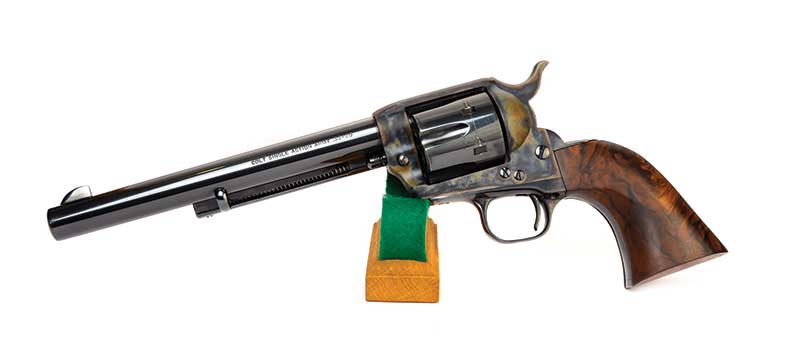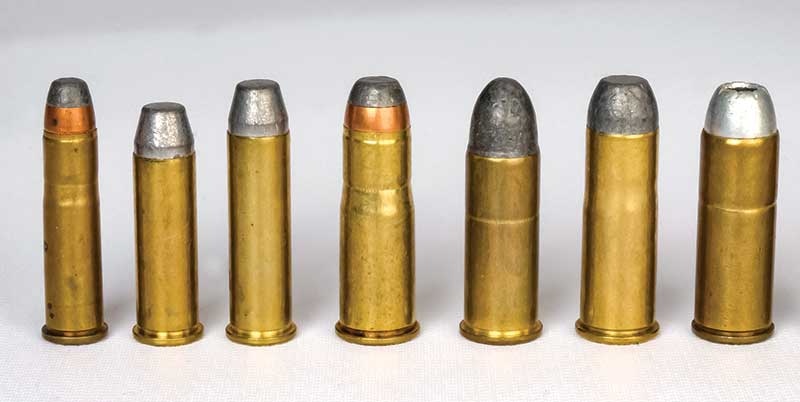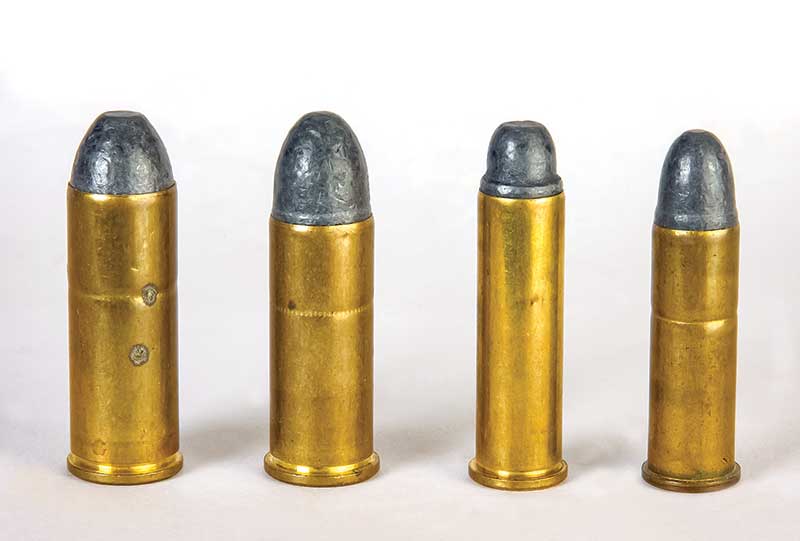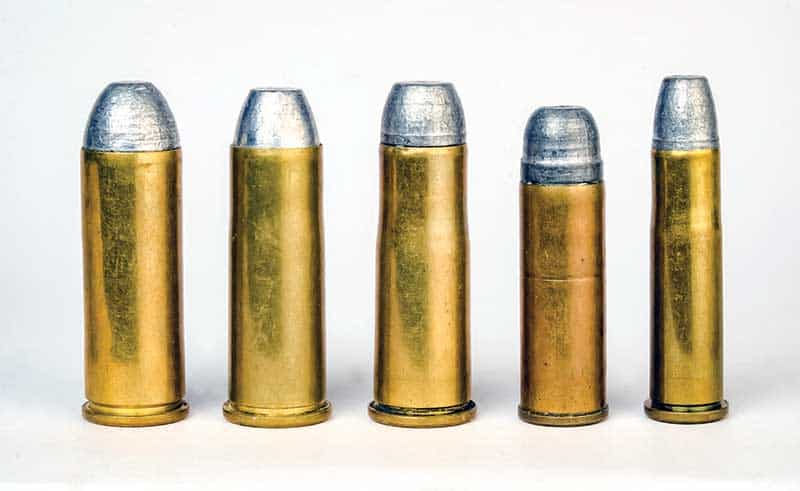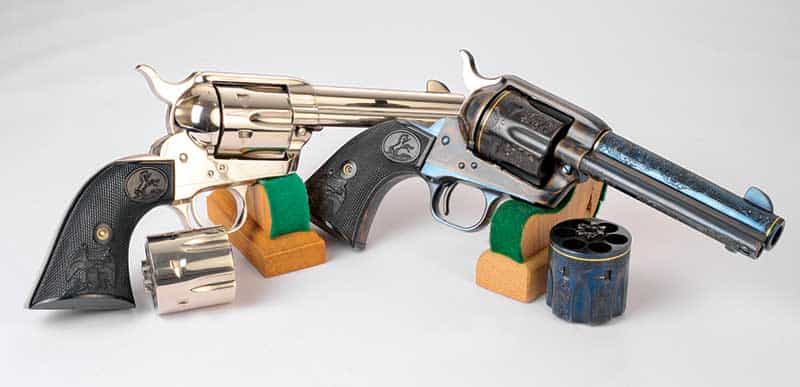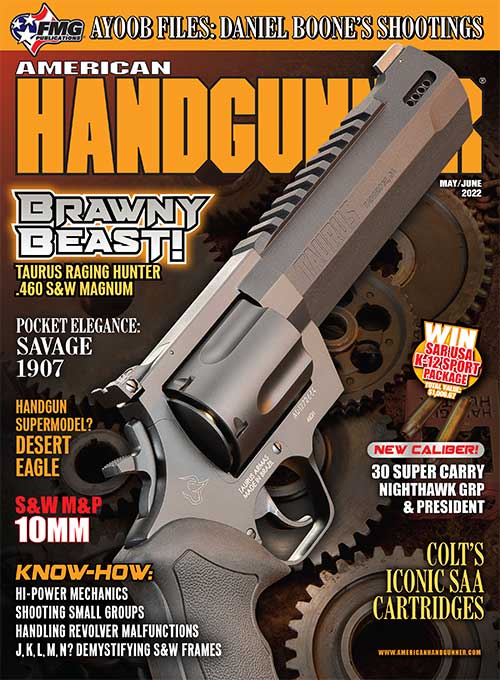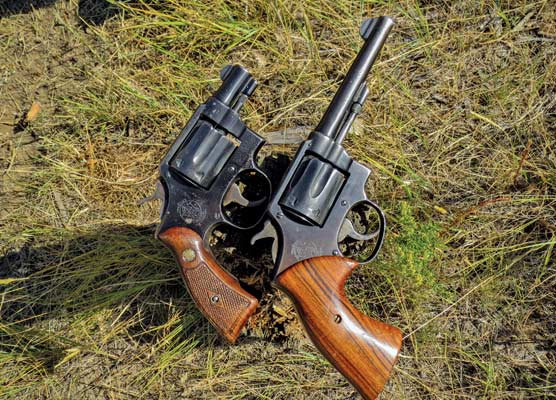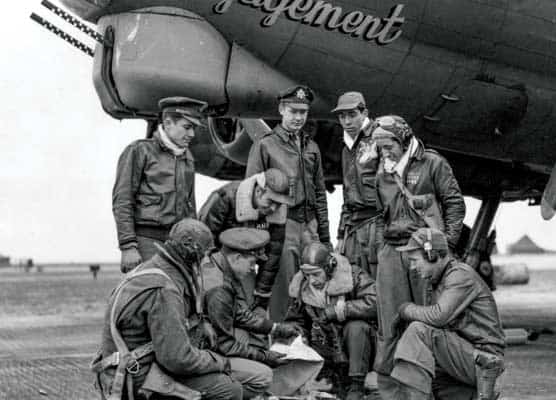Colt's Great Eight: The Most Iconic Colt SAA Cartridges
After 50 years of shooting and experimenting, I’ve come to think of eight cartridges as Colt’s Great Eight. A book titled The 36 Calibers of the Colt SAA by David M. Brown was printed in 1965. The 36 SAA calibers detailed in the book were in the 1st Generation of production from 1873 to 1941.
With over 100 Colt SAAs passing through my hands starting in 1968, only in 2020 did I finally manage to gather at least one each the Great Eight at the same time. They span all three generations.
.32 WCF/.32-20
Since owning my first .32-20 circa 1980, I’ve eschewed the cartridge as too small, and SAAs chambered for it as too heavy. However, upon spotting this 3rd Generation one with a 71/2″ barrel in late 2020, I realized owning it would fulfill my quest to have all the Great Eight. If I do my part from sandbags, it will cluster bullets in quarter to half-dollar size groups. A former owner had erased its color case hardening because it had gathered some surface rust along the way. It’s a keeper, so it was re-colored by Spring Creek Armory in Ten Sleep, Wyo.
.38 S&W (& Colt) Special
The .38 S&W or Colt Special was offered in all three generations of SAAs. Some .38 Colt Specials differed minutely in chamber from S&W .38 Specials. However, both would fire .38 Special ammunition, whether labeled Colt or S&W. Mine was made in 1957 and shipped to a sporting goods store in Colorado. It was still in mint condition when I purchased it in 2019. As will be gathered by sharp-eyed readers, I prefer 71/2″ barrels on my SAAs whenever possible. One might ask, “Why did Colt offer .38 Specials when so many smaller size and lower price handguns were available at the same time?” The answer is the popularity of the .38 Special. It is indeed exceptional in terms of accuracy and versatility.
.357 Magnum
In 1935, S&W unveiled their first magnum revolver — .357 S&W Magnum — and its cartridge, which was simply the .38 Special case lengthened from 1.16″ to 1.290″. Cylinders were made of a special alloy due to the .357’s high pressures relative to other revolver cartridges. Colt quickly followed with their large frame New Service and the Colt SAA. Only about 500 of the latter were made. However, it became second most popular in 2nd Generation production. Mine with the 43/4″ barrel was purchased new when I turned 21 in 1970. I sold it twice, luckily to friends from whom I bought it back, although it’s still likely my least fired Colt SAA.
.38 WCF/.38-40
If forced to pick a favorite SAA cartridge, it would be tough to decide between .38-40 and .44-40. Although I have a half dozen others to choose from, my favorite .38-40 was shipped to Salt Lake City Hardware in 1926. It has a 71/2″ barrel and overall brown patina finish without pitting. Its grips didn’t fit, so I had Bill Fuchs of Spring Creek Armory in Ten Sleep, Wyo., make a plain walnut set of the one-piece type to match its finish. It shoots right to its sights. Colt began chambering for this round in 1884 and it became the third most popular among 1st Generation cartridges. It was brought back in 1993 and wasn’t dropped until well into the 21st century.
.41 Colt
A little-known fact is Colt always used the same barrels for .38-40 and .41 Colt. Their factory specs for barrel groove dimensions were 0.401″/0.402″. How so? Because the .38-40 isn’t a .38. It’s a .40 caliber. And the .41 Colt isn’t a .41. It’s a .38 because bullets in its smokeless powder factory loads are only 0.386″. That necessitates the bullets having deep hollow bases to expand to grip the rifling. My .41 Colt is in fine shape. Barrel length is 51/2″, and it was shipped in 1902 to Simmons Hardware in St. Louis, Mo. I had to hunt down three .41 Colt die sets: Lyman, RCBS and Redding to finally get a combination to fit my needs. Be aware .41 Colt dies by the first two manufacturers are no longer made, so I mean literally “hunt down.” The same phrase applies to finding suitable hollow base bullets.
.44 Special
The .44 Special is the .44 Russian case stretched from 0.97″ to 1.16″. I’ve often drawn the ire of dedicated .44 Special shooters when I say it isn’t so special. Don’t get me wrong. It’s a darn fine round, but I’ve found it has neither the accuracy potential nor versatility of the .38 Special. As with .38 Special and .357 Magnum, the .44 Special has been included in all three production generations. I’m sure more were made in the 3rd Generation than the first two combined. My only SAA .44 Special wears a 51/2″ barrel, was made in 1961 and shipped to a dealer in Chicago. Worthy of note is that I searched out blued and nickeled .44 Special cylinders for two of my SAA .44-40s. As with .38-40/.41 Colt, the company always used the same barrel specs for their .44s.
.44 WCF/.44-40
It just about depends on the exact day whether I favor .38-40 or .44-40 most. At this writing, my favorite is a very fine condition 71/2″ .44-40 made in 1913 and it factory letters to a Vertuli Hardware Company address unknown. It has the roll mark on the barrel’s left side: Colt Frontier Six-Shooter .44-40. From a machine rest, I fired it for groups with 20 different handloads and the average was 1.99″. Not bad for a 108-year-old revolver.
Colt began offering .44 WCF in 1877 (some sources say 1878), and it quickly grew in popularity, but sales slowed dramatically toward the end of SAA production in 1941. An interesting bit of information is early Colt CFSSs did not have the 0.427″-barrel groove diameter of later ones. They were only 0.424″/0.425″. Regarding standard production, Colt only offered .44-40 in 1st and 3rd Generations. I was at the 1982 NRA Convention in Philadelphia when they announced .44-40 SAAs would be made once more. I ordered one right there on the spot.
.45 COLT
Of course, the all-time most popular Colt SAA chambering has been .45 Colt and was the introductory cartridge in 1873 for Colt’s brand new “Strap Pistol.” It has been most popular in all three generations. The first barrel length was 71/2″ issued to U.S. Cavalry troops until the 1890s. The 51/2″ length came out circa 1875, and the very popular 43/4″ length was standardized in 1879, although Colt made some on special order before that. It seems Colt offered their new sixgun from the beginning in nickeled finish and blue/color case hardened. I’ve seen Colt .45s with barrels as short as 2″ and as long as 16″.
My very first Colt SAA was bought in 1968 when I lived in West Virginia. It wore a 51/2″ barrel and had been built in 1964. I was working at a freight company during summer vacation after my first year of college. One of the truck drivers, a “windy” sort, said he had a “Colt .45.” I asked, “Automatic?” He said, “Nope, a revolver, one of those cowboy guns.” I bugged him for weeks to bring it so I could at least see it, but he never did. Figuring he was blowing smoke, I gave up. One Friday payday, just as I got home, he called and said, “If you want to buy that .45 for $100, come meet me at the docks.” That was about all my take-home pay, but I hot-footed it back there and was surprised he had what he bragged he had. It was pristine and started me on the SAA path to this day. Too bad I don’t have it still. Living in Montana by that time, I sold it in 1977 because I wanted a new scope for my latest fixation — varmint shooting.
I currently have more .45s than the other chamberings, with barrel lengths ranging from 31/2″ to 12″ in nickel finishes, blue/color case hardened, and full blue. There is a target sighted New Frontier .45 in with them, which was a present from Hank Williams Jr. the first time he invited me to his home. Colt Peacemaker .45s may not be my favorite, but they are near the top, by golly!
That’s it, a brief history of the Colt SAA’s Great Eight. I’ll never get tired of Colt SAAs of any caliber!


